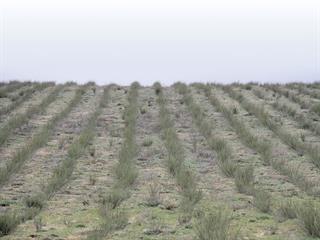
A combination of sandy soil and the effect of wind on the escarpment of the Bokkeveld Mountains forming the border between the Western and Northern Cape near Nieuwoudtville often poses severe problems for the area’s rooibos tea producers.
At times, sandstorms resembling fog sweep over the ridge, reducing visibility and resulting in extensive soil erosion on poorly established rooibos lands. The easterly winds are especially strong, while wind from the south is not uncommon.
In years of normal winter rainfall, the area’s rooibos producers use crop rotation to limit the effect of wind erosion. But Pierre Rossouw from Meulsteenvlei near Nieuwoudtville is doing something new: conducting trials on establishing new rooibos lands with a specialised no-till planter he designed in cooperation with Piket Implements. After his family bought Meulsteenvlei in 2007, Pierre began by following traditional rooibos production practices.
In this winter rainfall area with an average annual rainfall of 700mm, he ploughed the lands set aside for new rooibos plantings in early winter instead of in July and August when it is often too wet and windy. (Because weeds usually germinate on the ploughed land before he can start planting in August, Pierre first sprays Roundup on the weeds and then plants when the dead weeds still cover the soil surface.)

Inside the laboratory of Nieuwoudtville Rooibos. The industry maintains strict quality control. An external laboratory is contracted to carry out residue testing. Tea cannot be exported unless the Perishable Products Exports Control Board has tested the tea for salmonella and E.coli.
While preparing the seed beds, he soon discovered that he was bringing heaps of stones to the surface by ploughing too deeply. He had to remove these and then level the surface with a roller. As a result, he sold his mouldboard ploughs and started using an offset disc plough and roller to keep soil disturbance to a minimum. In other words, he no longer worked in topsoil too deeply and reduced compaction.
This year, Pierre went a step further and conducted no-till trials, planting rooibos seed directly into the stubble of an unploughed land showing signs of a flourishing earthworm population.
Specialised equipment
With the help of Piket Implements, Pierre has been working on developing a custom-made no-till planter for rooibos over the past few years. To solve the problem of a variable planting depth on an uneven surface, he replaced the Piket no-till planter units with John Deere units that incorporate depth control wheels on either side of the V-opener with press wheels at the back. Floating arms on a parallelogram system enable the planter to follow the contour independent of depth control. The Piket frame and fine seed metering units were kept.
For soil preparation, spraying and planting, Pierre uses a tracked 6930 John Deere tractor with GPS device and auto-steer. Using a computerised programme, he gains on average two more rows per hectare. The seeding density is 0,5kg/ha.
Overcoming challenges
Conservation farming practices are increasingly being accepted in South Africa, but not yet by rooibos producers. However, as implemented on Meulsteenvlei, they are expected to halve the farm’s diesel use and significantly reduce wear and tear of implements.
Disadvantages include the increased use of chemicals – unless a knife-roller can control weed growth. In the rooibos production areas of Nieuwoudtville and Clanwilliam, the proliferation of rush-like restios could be another problem when farmers stop ploughing, while rodents may also damage rooibos plants at night. However, Pierre remains committed to finding innovative solutions, such as encouraging owls to catch the rodents by erecting owl houses and hunting perches.
Along with spraying herbicide and controlling weeds with knife rollers, rooibos producers traditionally use insecticides to control insect pests such as leaf hoppers. When the January harvesting season draws closer, Pierre uses much more expensive organic insecticide sprays.
Arable land
Meulsteenvlei consists of almost 2 000ha on the escarpment and just more than 2 000ha on the Knersvlakte below the Bokkeveld Mountains, where Pierre’s daughter Joha farms Dohne Merino and Dorper sheep. Here, the average annual rainfall is a mere 250mm. The farm’s arable land on the escarpment totals 600ha, of which 500ha is suitable for rooibos production. Of this, Pierre currently uses only 360ha.
The lifespan of a rooibos stand is four years. Pierre incorporates rooibos in a crop rotation system with oats and lupins for two years before and after the rooibos. Achieving a good plant stand is crucial, he says and aims for 8 000/ha to 9 000/ha. The average price of seed is R300/kg, but reaches R1 400/kg during times of scarcity or when the producer price of tea increases.
The latter is currently around R29/kg, says Pierre.

A close-up of a rooibos tea plant taken during winter when the tea bushes were in a resting phase.
“Depending on the price, I sign a contract with either Rooibos Ltd in Clanwilliam or Nieuwoudtville Rooibos to buy my crop after it has been dried on the farm,” he adds. He normally achieves a B-grading, with A being the highest and D the lowest.
In normal years, the yield is more than 1t/ ha dry weight. Pierre’s best yield of 1,7t/ ha was in 2011. Yield can drop to 350kg/ha during drought. Rooibos plants are affected by abnormally dry winters and are sensitive to cold summers.
High phosphate levels
A soil analysis on lands with exceptionally good stands revealed relatively high phosphate levels. Pierre stresses that the natural soil phosphate level differs from area to area according to the long-term annual rainfall. Normally, he applies superphosphate at 300kg/ha, 3t/ha agricultural gypsum (to enhance uptake) and trace elements. He increases the soil’s pH from 4,5 to 5,5 by applying agricultural lime to limit the growth of sorrel (Oxalis sp).
Currently, Meulsteenvlei derives 80% of its income from rooibos and 20% from the Dohne Merino and Dorper flocks of 500 ewes each. Pierre aims to change the ratio to 70:30.
Email Pierre Rossouw at [email protected].








